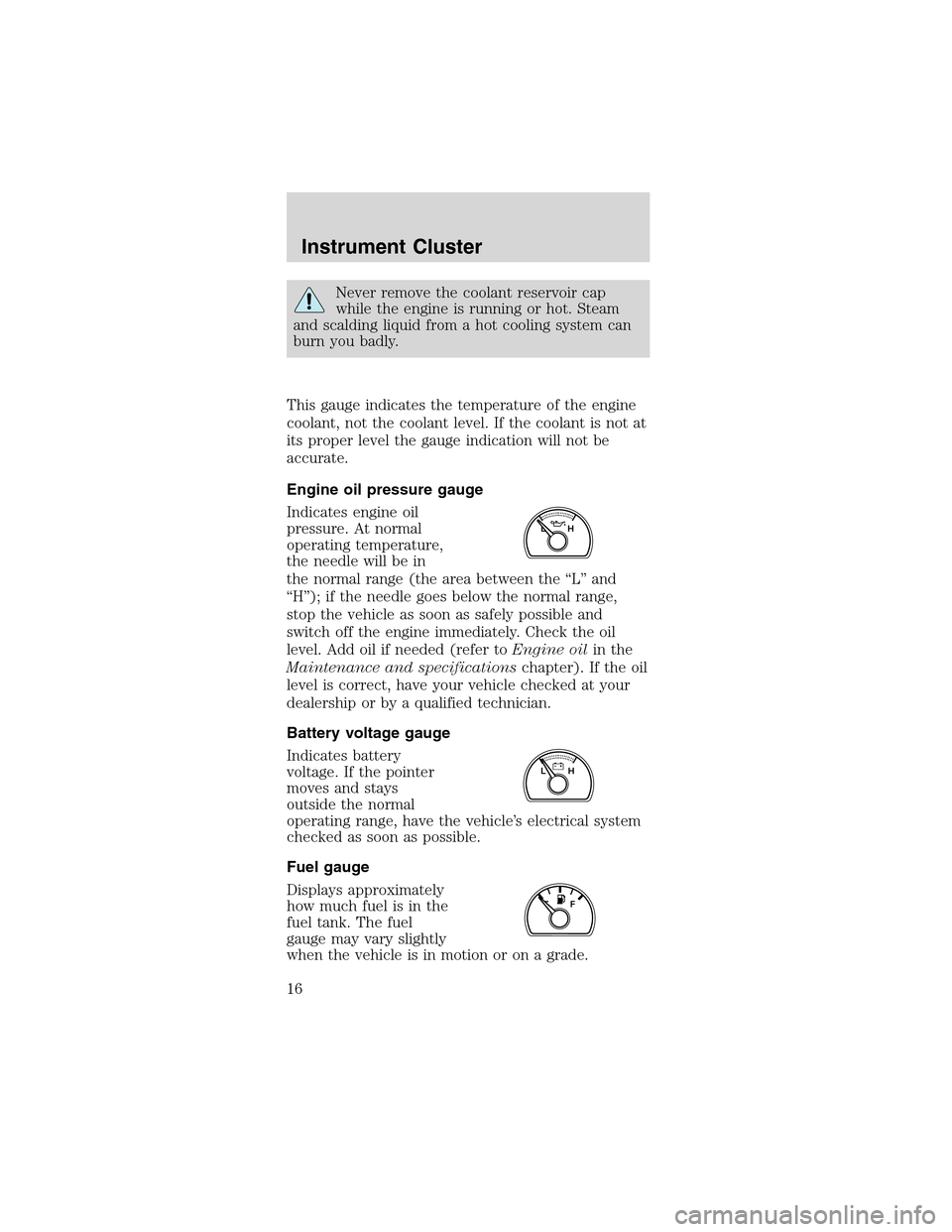Page 9 of 256
Vehicle Symbol Glossary
Interior Luggage
Compartment
Release Symbol
Panic Alarm
Engine OilEngine Coolant
Engine Coolant
TemperatureDo Not Open When
Hot
BatteryAvoid Smoking,
Flames, or Sparks
Battery AcidExplosive Gas
Fan WarningPower Steering
Fluid
Maintain Correct
Fluid LevelMAX
MINEmission System
Engine Air FilterPassenger
Compartment Air
Filter
JackCheck fuel cap
Low tire warning
Introduction
9
Page 16 of 256

Never remove the coolant reservoir cap
while the engine is running or hot. Steam
and scalding liquid from a hot cooling system can
burn you badly.
This gauge indicates the temperature of the engine
coolant, not the coolant level. If the coolant is not at
its proper level the gauge indication will not be
accurate.
Engine oil pressure gauge
Indicates engine oil
pressure. At normal
operating temperature,
the needle will be in
the normal range (the area between the“L”and
“H”); if the needle goes below the normal range,
stop the vehicle as soon as safely possible and
switch off the engine immediately. Check the oil
level. Add oil if needed (refer toEngine oilin the
Maintenance and specificationschapter). If the oil
level is correct, have your vehicle checked at your
dealership or by a qualified technician.
Battery voltage gauge
Indicates battery
voltage. If the pointer
moves and stays
outside the normal
operating range, have the vehicle’s electrical system
checked as soon as possible.
Fuel gauge
Displays approximately
how much fuel is in the
fuel tank. The fuel
gauge may vary slightly
when the vehicle is in motion or on a grade.
LH
LH
F
Instrument Cluster
16
Page 222 of 256

•Using the air conditioner or defroster may reduce
fuel economy.
•You may want to turn off the speed control in
hilly terrain if unnecessary shifting between third
and fourth gear occurs. Unnecessary shifting of
this type could result in reduced fuel economy.
•Warming up a vehicle on cold mornings is not
required and may reduce fuel economy.
•Resting your foot on the brake pedal while driving
may reduce fuel economy.
•Combine errands and minimize stop-and-go
driving.
Maintenance
•Keep tires properly inflated and use only
recommended size.
•Operating a vehicle with the wheels out of
alignment will reduce fuel economy.
•Use recommended engine oil. Refer toLubricant
specificationsin this chapter.
•Perform all regularly scheduled maintenance
items. Follow the recommended maintenance
schedule and owner maintenance checks found in
your vehicle scheduled maintenance guide.
Conditions
•Heavily loading a vehicle or towing a trailer may
reduce fuel economy at any speed.
•Carrying unnecessary weight may reduce fuel
economy (approximately 0.4 km/L [1 mpg] is lost
for every 180 kg [400 lb] of weight carried).
•Adding certain accessories to your vehicle (for
example bug deflectors, rollbars/light bars,
running boards, ski/luggage racks) may reduce
fuel economy.
•Using fuel blended with alcohol may lower fuel
economy.
•Fuel economy may decrease with lower
temperatures during the first 12–16 km (8–10
miles) of driving.
Maintenance and Specifications
222
Page 251 of 256

running out
of
fuel ......................... 218
safety information
relating to
automotive fuels ... 214
Fuses ........................ 160
G
Gas cap
(see Fuel cap) ... 12, 216
Gas mileage
(see
Fuel economy) ........ 219
Gauges ....................... 15
battery voltage
gauge ....................... 16
engine coolant
temperature
gauge ....................... 15
engine oil pressure
gauge ....................... 16
fuel gauge ................ 16
odometer ................. 17
speedometer ........... 17
tachometer .............. 17
trip odometer .......... 18
GAWR (Gross Axle
Weight Rating) ........ 154
definition ............... 154
driving with a
heavy load ............. 154
location .................. 154
GVWR (Gross Vehicle
Weight Rating) ........ 154
calculating ............. 154
definition ............... 154
driving with a
heavy load ............. 154
location .................. 154H
Hazard flashers ....... 158
Head restraints ......... 99
Headlamps ................. 67
aiming ................ 68–69
bulb specifications .. 71
daytime running
lights ........................ 67
flash to pass ............ 68
high beam ......... 10, 68
replacing bulbs ....... 72
turning on and off .. 67
warning chime ........ 15
Heating
heating and air
conditioning
system ..................... 63
Hood ........................ 196
I
Ignition ............. 133, 242
removing the key .. 153
Infant seats (see
Safety seats) ........... 123
Inspection/maintenance
(I/M) testing ............ 224
Instrument panel
cleaning ................. 190
cluster ...................... 10
lighting up panel
and interior ............. 68
J
Jack .......................... 165
positioning ............. 165
storage ................... 165
Index
251